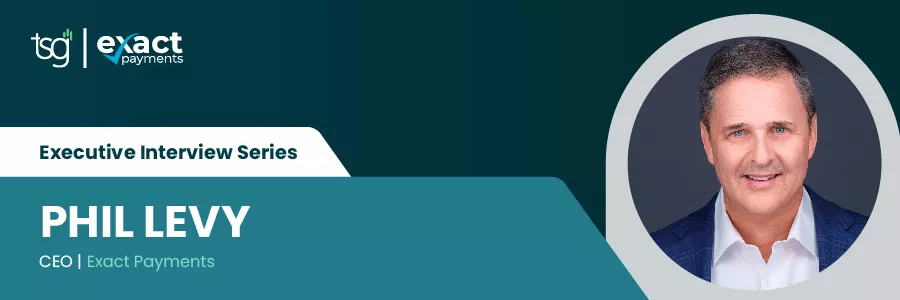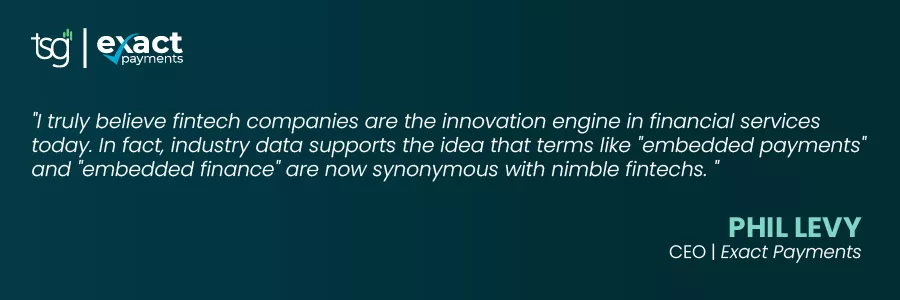
The Executive Interview Series provides readers exclusive insights from movers and shakers in the payments industry. The payments industry is under continuous transformation. This series offers diverse perspectives on everything from strategy to payments technology and the industry’s future.
In this interview, TSG Marketing team member Rachel Hartley spoke with Phil Levy, CEO of Exact Payments, to discuss the company’s role within the broader payments ecosystem, covering various topics such as growth initiatives, prevailing trends, and the company’s commitment to optimizing payment experiences.
Phil Levy is a payments industry veteran with more than 18 years experience in senior and executive leadership roles. Most recently, Phil was Managing Director, Payments at Silicon Valley Bank where he was responsible for building and managing the merchant services business serving the company’s portfolio of Fintech, eCommerce and Life Sciences companies. Prior to SVB, Phil led product strategy, product development and business development for industry leaders including Fiserv/First Data, FIS and eFunds Corporation.
Q: Rachel H.
How have your prior experiences at companies like FIS, Fiserv, and SVB shaped how you approach your role at Exact Payments?
A: Phil L.
Like many people, I happened into the financial services technology industry by chance. I started my career in technology and have been in both hardware and software businesses. My first fintech venture went by an interesting tongue-twister of a name — Financial Settlement Matrix. FSMx, for short, was building an online bill presentment and settlement platform for industry marketplaces. That was 20 years ago. Even then, dozens of companies were building solutions for converting B2B procurement from paper to electronic. And, of course, B2B automation continues to be a major growth segment for companies like Exact Payments today.
Over my years in Fintech, I’ve worked for industry leaders, including FIS, Fiserv, and SVB. The common thread is that each of these companies builds systems that operate at a massive scale to support some of the world’s largest and most innovative merchants, financial institutions, and software platforms. From authorization switches to boarding systems and payment gateways, I’ve been involved with large-scale projects, sometimes involving hundreds of developers at a time. When done well, I’ve seen first-hand how technology solutions really do lead to great outcomes for customers.
This is our vision at Exact Payments — to build the easiest-to-integrate, most scalable, and highest-reliability payment solutions available in the industry.
Q: Rachel H.
What is the mission of Exact Payments? Why is a company like Exact Payments an asset to the payments space?
A: Phil L.
At Exact, our mission is to “Propel Payments for Software Platforms.” For us, this means always driving payments forward for clients. We want to be the payment engine embedded into their software solutions, turning the wheels of commerce and ensuring smooth growth as the business scales. Everything we do, every investment we make, is designed to enable seamless integration of payments into our partners’ platforms.
Technology lies at the core of our value proposition. But, our force multiplier comes from the integration of a tech platform with our team of payments experts. From the time we engage with a software partner to implementation and ongoing support, we offer expert guidance at every stage, so the solution is highly customized to meet their needs.
For example, our onboarding and underwriting module is fully API-enabled with drag-and-drop technology. This allows clients to build and manage an unlimited number of automated underwriting scorecards. Every partner works with a dedicated risk analyst to optimize their underwriting strategy. They ensure and take full advantage of advanced services like Plaid and Trulioo. With custom scorecards specific to their business and guidance from risk experts, our partners benefit from highly accurate underwriting decisions and higher approval rates.
Q: Rachel H.
How do you see the role of fintech companies evolving in the payments ecosystem. How does Exact Payments fit into that ecosystem?
A: Phil L.
I truly believe fintech companies are the innovation engine in financial services today. In fact, industry data supports the idea that terms like “embedded payments” and “embedded finance” are now synonymous with nimble fintechs.
Exact Payments is at the forefront of this. As we are a team of industry veterans who believe commerce works best when seamlessly integrated into the software developed specifically to solve the needs of defined verticals.
My favorite example here is fundraising software. Churches, schools, youth organizations, and national charities have so many options to consider for automating their business’s “revenue” function using this software. Yet, only 40% of software platforms have semi-integrated or embedded payment solutions. Of course, my first thought is to use embedded payments as a first filter in vendor selection. But my second thought is, how can donation payments exist outside the software platform? A disjointed experience clearly adds friction for every donor.
That is where Exact Payments fits. We want to optimize payment experiences and eliminate transaction friction for software partners. Once that friction is removed, you can almost guarantee gains in customer satisfaction, retention, and revenue.

Q: Rachel H.
What are some of Exact Payments’ growth initiatives for the next year?
A: Phil L.
We have an ambitious roadmap for the second half of 2023 going into 2024. I’ll point to two exciting initiatives we are working on right now.
The first is our launch of network tokenization later this summer. We partnered with Visa to integrate Visa’s token gateway service, which supports network tokenization for all four card networks. Everyone wins with network tokenization, starting with merchants who benefit from an increase in authorization rate, reduction in interchange, and improved security.
The second initiative is expanded support of digital wallets, which are rapidly gaining market share in North America. We support Apple Pay, Google Pay, and Paypal today. Later this year, we’ll launch Click to Pay in partnership with Mastercard, with a number of other integrations planned going into 2024.
Q: Rachel H.
Touch on the Exact Payments platform. What features strengthen the interaction users have with the technology?
A: Phil L.
While our Payfac-as-a-Service (PFaaS) solution is an API-first platform, our portal has some powerful features for users across functions in the business, including finance, risk, operations, and customer support.
One example is our Underwriting module, which enables our risk team to communicate directly with partners and merchants in the portal. When additional documents are needed to complete an underwriting review or update annual PCI records, there is no need for offline emails or inevitable time delays. Our clients receive requests and respond right within our portal and have the ability to upload and store documents securely.
Q: Rachel H.
What trends do you see around APIs in the payments space?
A: Phil L.
You’ll hear terms like “low code” and “no code.” We’re following this by simply building integration options that are cleanly designed, easy to integrate, and robust. Software partners integrating with our PFaaS platform need only our merchant onboarding API. After that, payment, settlement, funding, and chargebacks are all managed within the Exact platform. We also offer a no-code option that lets the partner embed or link to our hosted merchant application as a step in their client onboarding process — simple and secure.
Related: Recognizing Leading Payment Gateways with 2023 API Awards
Q: Rachel H.
Where do you feel the industry is heading in the next five years?
A: Phil L.
I’ll be bold here and say ubiquity. That’s where embedded payments and embedded finance solutions are going. Now, it may take more than five years, but I am absolutely confident that payments inside vertical SaaS is the future.
Last year, it was forecasted that 15% of global GDP would ultimately run through SaaS platforms. In 2022, global GDP was $95 trillion. So while true, 15% may not yet be ubiquitous, it’s a huge number and a massive opportunity we are enabling for our partners along with other innovators in the space.
Other Content: